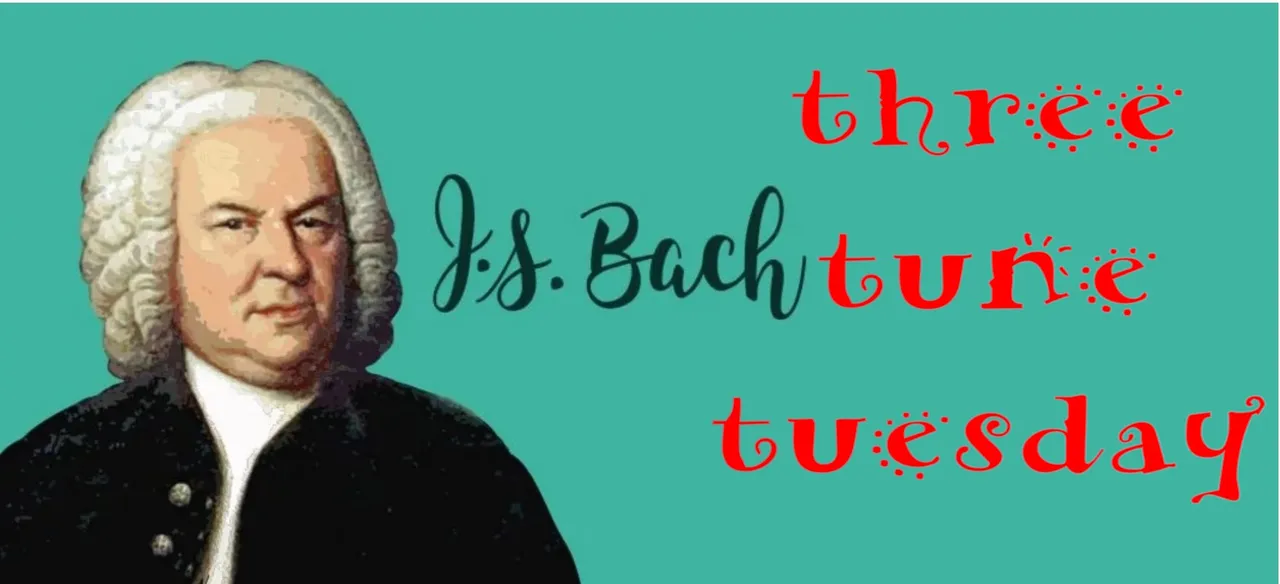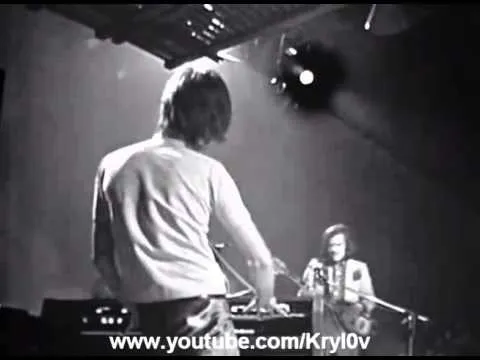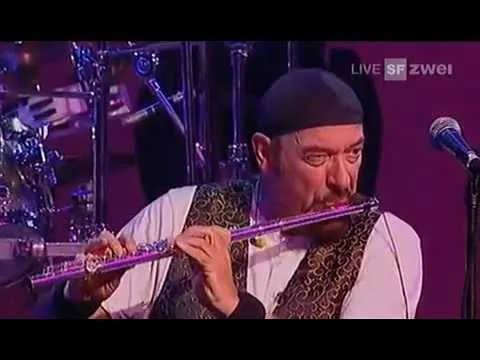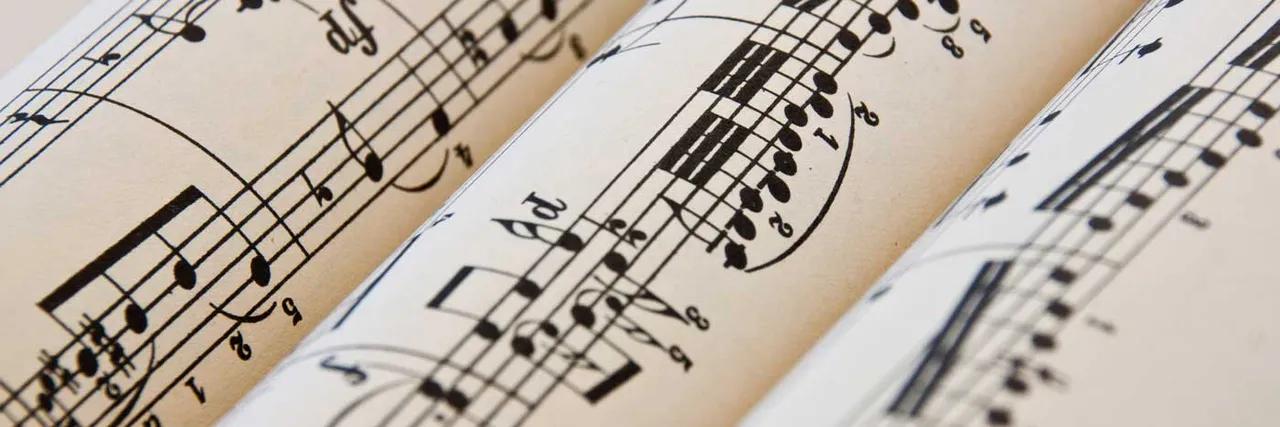
This, or something very similar, is probably what some of the musicians of our time thought when they came to terms with what the man from Eisenach had immortalised on a sheet of music some 300 years ago. There is no denying that Johann Sebastian Bach is no exception. People like to take a look at the "old" masters in the recording studio and steal a few bars here and there, or even a whole passage. Why is this? Because the "old masters" were, for the most part, simply good at what they composed and left behind. The stealing of harmonies is not a modern invention at all. Not at all, because Liszt, Mendelssohn, Mozart, Reger and Schönberg all borrowed from Mr Bach in their day. Rock 'n' roll liked to borrow from Beethoven and the very adaptable from Maurice Ravel.
But for #threetunetuesday, brought to life by @ablaze, the focus is exclusively on the genius whose works put every mediocre piano player or organist in a kind of state of shock. However, there are some remarkable exceptions that have truly managed to live up to the composer's standards.
Nicht übel, was dem Kollegen Bach (Johann Sebastian) einst eingefallen ist.
So, oder ganz vergleichbar, hat es sich wohl auch der eine oder andere Musiker unserer Zeit gedacht, als er oder sie sich mit dem auseinandersetzte, was der Mann aus Eisenach vor ungefähr 300 Jahren auf dem Notenpapier verewigt hat. Unbestreitbar ist da Johann Sebastian Bach keine Ausnahme. Liebend gerne riskiert man im Tonstudio einen Blick zu den “alten” Meistern und klaut mal hier oder dort ein paar Takte oder gleich eine ganze Passage. Warum? Weil die »Alten« meist einfach gut in dem waren, was sie komponierten und hinterließen. Harmonien zu “klauen” ist dabei keine neuzeitliche Erfindung. Keineswegs, denn Liszt, Mendelssohn, Mozart, Reger oder Schönberg haben sich zu ihrer Zeit bereits bei Herrn Bach bedient. Der Rock ’n’ Roll liebend gerne bei Beethoven und die ganz Anpassungsfähigen bei Maurice Ravel.
Doch für den #threetunetuesday, ins pralle Leben befördert von @ablaze, rückt exklusiv der Genius in den Fokus, dessen Werke jeden mittelmäßigen Klavierspieler oder Organisten in eine Art Schockstarre versetzen. Allerdings existieren dennoch bemerkenswerte Ausnahmen, die es wahrlich geschafft haben, den Ansprüchen des Komponisten gerecht zu werden.

I'd like to start this #ttt with an Englishman who has shown himself to be a passionate Bach fan at every opportunity. Whether it be fragments of the Brandenburg Concertos, the Toccata and Fugue in F Major (BWV 540), the French Suite No. 1 (BWV 812) or the Prelude in D Minor, Keith Emerson has devoted himself as an organist to these works as if they were close to his heart.
It began with The Nice, continued with Emerson, Lake & Palmer and ended with recording with the world's most acclaimed symphony orchestras. However, what Johann Sebastian Bach would have said about someone playing his complete D Minor Toccata and Fugue upside down, standing up front behind the Hammond organ, remains a mystery.
Den #ttt möchte ich starten mit einem Engländer, der sich zu jeder sich bietenden Gelegenheit als ein ausgemachter Bach-Fan zu erkennen gab. Ob Fragmente der Brandenburgischen Konzerte, der Toccata und Fuge in F-Dur (BWV 540), der 1. Französischen Suite (BWV 812) oder des d-Moll-Präludiums – Keith Emerson widmete sich als Organist diesen Werken, als wäre es eine Art Herzensangelegenheit.
Es nahm seinen Anfang in der Formation »The Nice«, setzte sich fort mit »Emerson, Lake & Palmer« und endete mit Aufnahmen inmitten der weltweit anerkanntesten Symphonie-Orchestern. Was Johann Sebastian Bach allerdings dazu gesagt hätte, dass jemand seine komplette Toccata und Fuge in d-Moll verkehrt herum spielen wird, nämlich an der Stirnseite hinter der Hammondorgel stehend, das bleibt ein zu lösendes Rätsel.


In 1969 the British band "Jethro Tull" released the album "Stand Up". The song "Bourée" can also be found on this album. This instrumental, flute-based song is an adaptation of the piece "Bourrée," written by Johann Sebastian Bach. The Bach version was written for lute, and is his fifth movement of the Suite in E minor for Lute. Also known as "Aufs Lautenwercke" (works for the Lute), Bach wrote the piece in the early 1700s.
When Ian Anderson was asked why he had chosen this particular piece by Bach, he replied in the following way: "I got to the point where I was playing the flute every night on stage in the early part of '68, and so by the end of the year, I was casting around for an instrumental piece as a successor to the Roland Kirk piece, 'Serenade to a Cuckoo,' which I'd been playing most of 1968. I wanted something that had a syncopated jazzy feel, but a melody that wasn't associated with the jazz world or the blues world. And 'Bourée' was a little bit of music that came to me through the floorboards of my bedsitter in London, because there was a media student in the room below who kept playing over and over again this refrain of the Bach tune "Bourée." He played it on classical guitar, but he only ever got the one bit, he never progressed beyond that basic thing. So I kept hearing that over and over and over and over again, and decided that I would try to use that little tune some way as a starting point for an instrumental piece".
1969 erschien das Album “Stand Up” von von der britischen Formation »Jethro Tull«. Darauf ist dann auch "Bourée" zu finden. Dieses instrumentale Lied für Flöte ist eine Bearbeitung des Stücks "Bourrée" von Johann Sebastian Bach. Die Bach-Version wurde für Laute geschrieben und ist der fünfte Satz der Suite in e-Moll für Laute. Bach schrieb das Stück, das auch als "Aufs Lautenwercke" bekannt ist, in den frühen 1700er Jahren.
Ian Anderson befragt, wieso er gerade auf dieses Stück von Bach zurückgriff, beantwortete er so: "Anfang 1968 war ich an einem Punkt angelangt, an dem ich jeden Abend auf der Bühne Flöte spielte, und so suchte ich gegen Ende des Jahres nach einem Instrumentalstück als Nachfolger für das Roland-Kirk-Stück “Serenade to a Cuckoo”, das ich fast das ganze Jahr 1968 gespielt hatte. Ich wollte etwas, das ein synkopisches, jazziges Gefühl hatte, aber eine Melodie, die nicht mit der Welt des Jazz oder des Blues verbunden war. Und 'Bourée' war ein kleines Stück Musik, das ich durch die Dielen meines Wohnzimmers in London hörte, denn im Zimmer darunter wohnte ein Medienstudent, der immer wieder diesen Refrain der Bachschen Melodie "Bourée" spielte. Er spielte es auf der klassischen Gitarre, aber er bekam immer nur das eine Stück hin, er kam nie über diese einfache Sache hinaus. Also hörte ich das immer und immer wieder und beschloss, diese kleine Melodie irgendwie als Ausgangspunkt für ein Instrumentalstück zu verwenden.”


Let's stay in the British Isles and turn our attention to another gifted keyboardist who started his career with "Deep Purple", later helped shape the musical direction as a member of "Whitesnake" and also enjoyed success as a solo artist. We're talking about "Jon Lord".
The keyboardist titled his J.S. Bach tribute "Bach Onto This", starting with the famous opening of the D Minor Toccata and Fugue (BWV 565), which many musicians find "rocky" and often quote. Lord's approach, however, is a different one, with a mixture of the original and his own composition. He does not follow the toccata in its entirety. He adds something of his own, but still ends up in the fugue.
Jon Lord explains his approach in the following way: "I've always wanted to play the fugue. But I would rather not play it in its entirety here. We excluded the middle section, which requires a lot of manual and register changes. I also ignored Bach's cadenza towards the end. The improvisation I play here is only loosely based on it. I am simply trying to give the music a modern interpretation at this point. It shows my somewhat schizophrenic musical personality: I love both classical and rock music.”
Verweilen wir weiterhin auf den britischen Inseln und wenden uns einem weiteren begnadet guten Keyboarder zu, der seine Karriere bei »Deep Purple« begann, später als Mitglied bei »Whitesnake« die musikalische Ausrichtung mitbestimmte und auch als Solo-Künstler erfolgreich war - die Rede ist von »Jon Lord«.
Dieser Keyboarder betitelte seinen Rückgriff auf J.S. Bach “Bach Onto This” und beginnt es mit dem berühmten Anfang der Toccata und Fuge in d-moll (BWV 565), der von vielen Musikern als „rockig“ empfunden und daher oft zitiert wird. Lord geht allerdings einen anderen Weg und vermischt das Original mit seiner eigenen Komposition. So folgt er nicht gänzlich der Toccata, sondern mischt Eigenes bei, endet aber dennoch in der Fuge.
Jon Lord erklärt seine Herangehensweise so: »Ich wollte immer schon die Fuge spielen. Aber ich habe mir nicht vorgenommen, sie hier komplett zu spielen. Wir haben den Mittelteil weggelassen, der viele Manual- und Registerwechsel verlangt. Ich habe auch Bachs Kadenz gegen Ende ignoriert. Die Improvisation, die ich hier spiele, bezieht sich nur lose auf sie. Ich versuche einfach, der Musik an dieser Stelle eine moderne Interpretation zu geben. Es zeigt meine etwas schizophrene musikalische Persönlichkeit: Ich liebe sowohl die klassische wie die Rockmusik.«


Das größte Interesse findet Johann Sebastian Bach übrigens unter den Jazz-Musikern. Doch explizit darauf einzugehen, würde den Rahmen sprengen. Vielleicht zu einem anderen Zeitpunkt?
Dennoch möchte ich euch zum Abschluss noch einige Beispiele auflisten, in denen musikalische Passagen des Mannes versteckt sind, der am 28. Juli 1750 in Leipzig starb.
Eminem: ‘Brainless’
- Johann Sebastian joins the American rapper in this 2013 outing. From 43 seconds in, you can catch Slim Shady rapping alongside the fugue subject from Bach’s famous Toccata and Fugue in D minor.
Eddie Van Halen: ‘Eruption’
- There’s more Toccata and Fugue-ing from the late heavy metal guitar maestro Eddie Van Halen, in this instrumental epic. Interestingly, the pioneers of heavy metal guitar studied Baroque, Classical and Romantic violin and virtuoso repertoire, and it went on to influence much of their style and technique. So never be surprised when you hear a Bach riff erupting from an epic Marshall stack like it does here.
Paul Simon: ‘Bridge over Troubled Water’
- Bach’s deeply beautiful four-part chorale ‘O sacred head now wounded’ lies behind one of pop’s abiding hits. Hear Paul Simon, of Simon and Garfunkel, in 1970 as he sits on a chat show and talks through the compositional process of Bridge over Troubled Water. Catch the Bachian fascination from six minutes in.
The Beatles: ‘Blackbird’
- One of Johann Sebastian Bach’s most famous works for lute is the musical inspiration behind this classic. Years later Paul McCartney described how Bach’s Bourrée in E minor lent its shape and harmony to the song’s iconic opening.
The Beatles: ‘All You Need Is Love’
- Links between Bach and the music of The Beatles run deep. As boys, Paul McCartney and John Lennon sang in Liverpool church choirs and would have encountered Bach’s church and organ music. The band’s producer George Martin also had a deep love and knowledge of Bach and Baroque forms. Like this moment, when one of his most joyous keyboard works, his Invention No. 8 in F, that rings out during the mammoth contrapuntal pastiche in the final section of ‘All You Need Is Love’.
The Beach Boys: Lady Linda
- These Californian rock-n-rollers gave us one of the greatest key changes in pop music. And we also have them to thanks for this hazy sun-and-sea-filled reworking of Bach’s ‘Jesu, Joy of Man’s Desiring’, from his cantata Herz und Mund und Tat und Leben, BWV147.
Lady Gaga: ‘Bad Romance’
- What’s that eerie harpsichord music at the beginning of Lady Gaga’s 2009 ‘Bad Romance’? It’s only the subject from the Fugue in B minor from Book One of the Well-Tempered Clavier.
Procol Harum: ‘A Whiter Shade of Pale’
- The arching melody and moving bass of ‘A Whiter Shade of Pale’ has an unmistakable resemblance to Bach’s Air on the G String. Interestingly, the music is perhaps more closely linked to Johann Sebastian’s exquisite instrumental Arioso from Cantata 156. But hey, it’s all Bach, right?
As I said: This is only a very small selection.
Wie bereits angedeutet - dies ist lediglich eine ganz kleine Auswahl.
